dish
Summary
Deep circular dish with wide press-moulded fluted rim and scalloped edge. Two holes pierced in rim edge, for suspension. Underside coated in white slip, upper surface decorated with trailed red and white slip, feathered in diagonal directions giving a diamond grid pattern. Slip colours show cream and dark brown through warm lead glaze, pooling brown in dish well.
Display Label
Clay Clay is an ancient, universal material. Dug out of the ground, it is basic stuff, formed by the elements, earth, water, air and fire. Its use is one of the oldest human artforms. Clay responds to the touch of your hand, it can be pushed and pulled, squeezed and pinched. Clay has no natural form of its own, and can be shaped into almost anything. It is tactile, inviting, immediate and intimate. When soft, it is marked by the slightest touch, yet once fired, it becomes fixed and permanent. A clay pot will survive for thousands of years, bearing the thumbprint of the potter who made it. Some makers are drawn by clay's physical appeal, its sensuous and tactile qualities. For others it is simply a means to an end, an incredibly diverse and expressive medium with the potential to do almost anything.
Object Name
dish
Date Created
1700
accession number
1923.163
Collection Group
Place of creation
Staffordshire
Medium
Credit
Bequeathed by Thomas Tylston Greg
Legal
© Manchester Art Gallery

